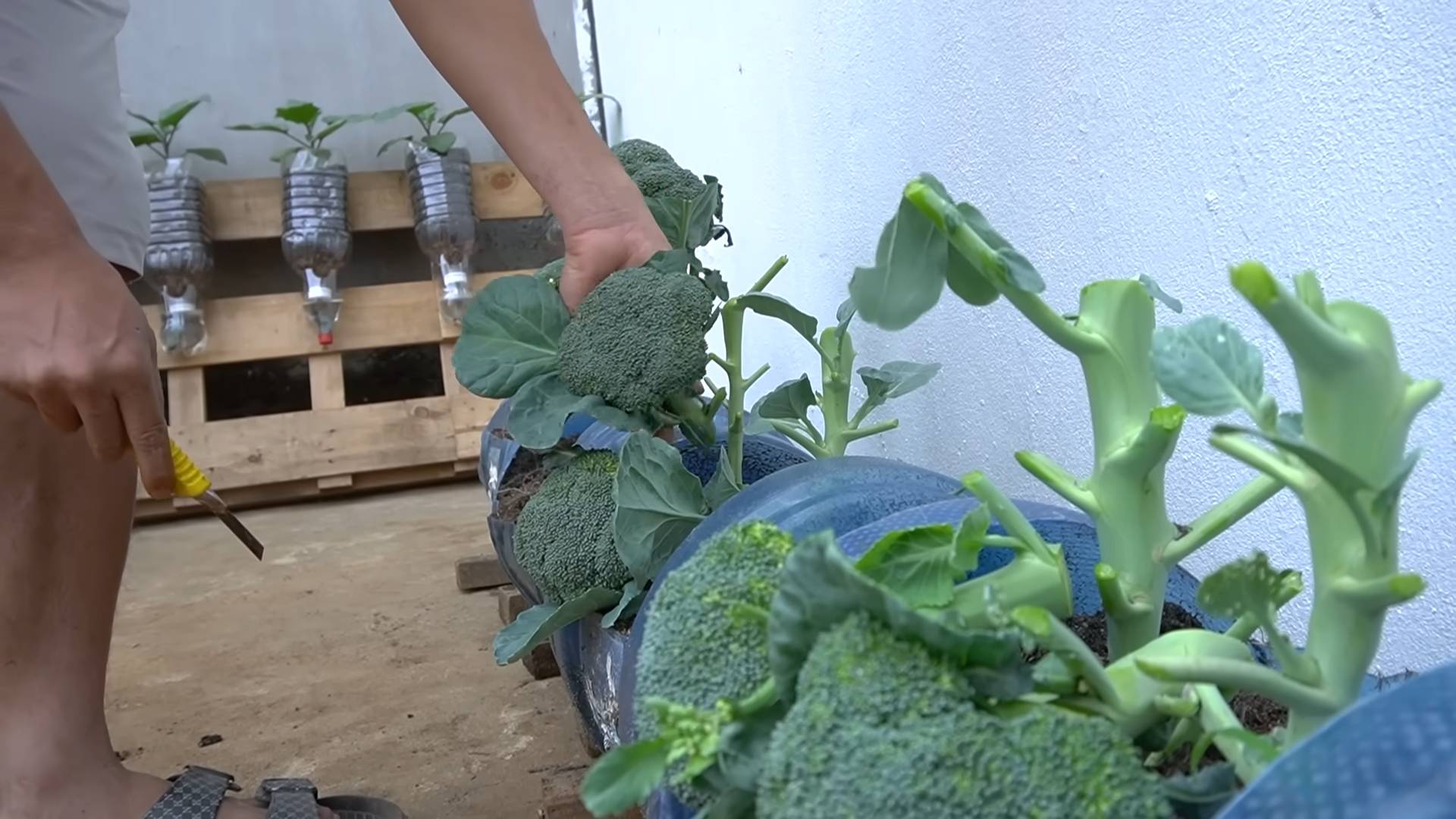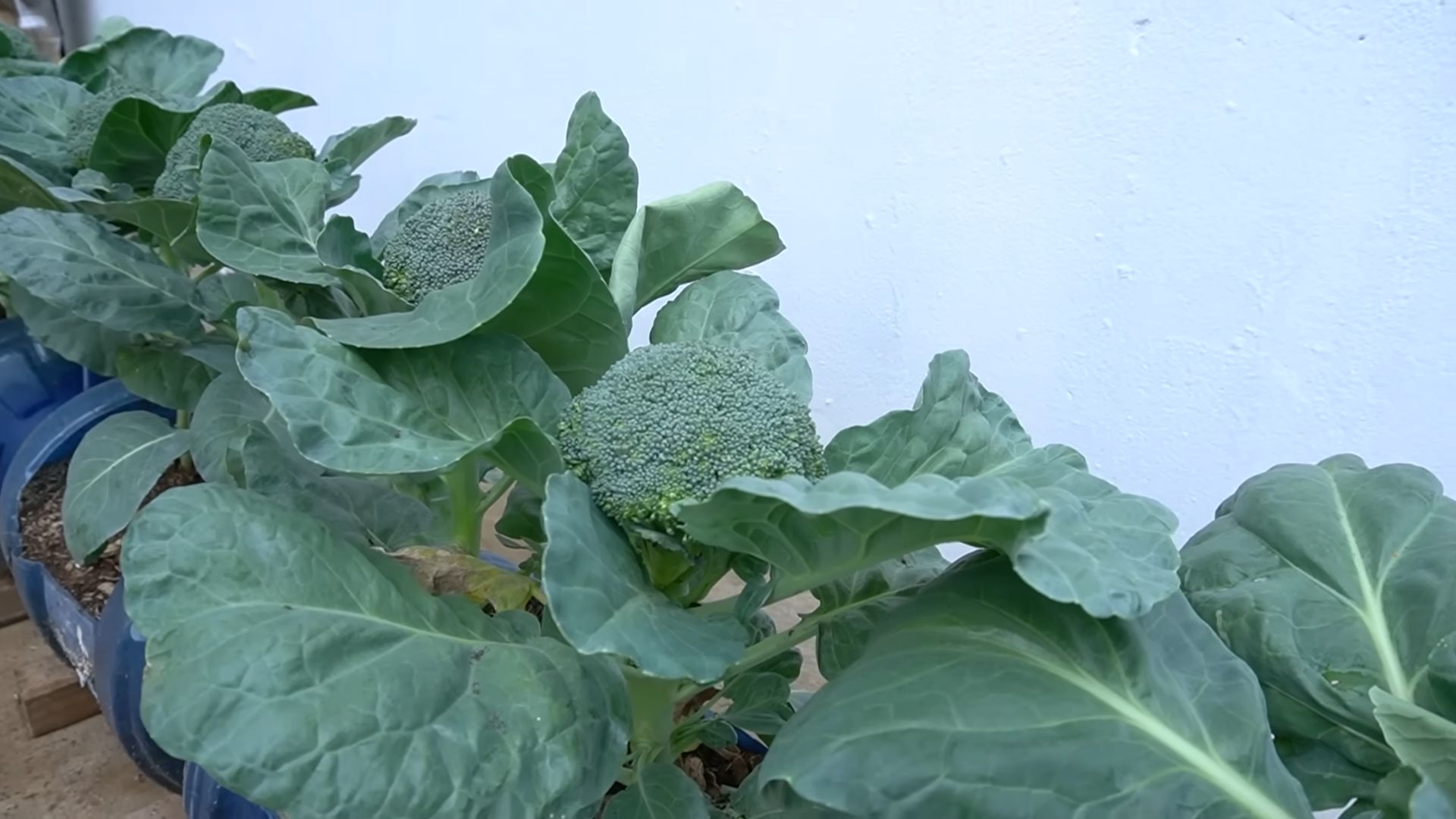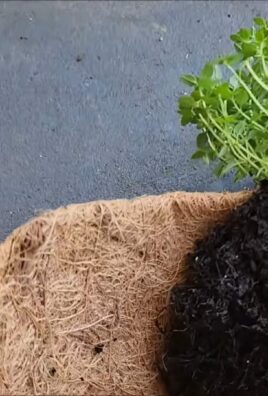Grow broccoli at home, even if you think you don’t have a green thumb! Have you ever dreamt of strolling into your backyard and harvesting fresh, vibrant broccoli for dinner? It’s more achievable than you might think, and this DIY guide is your ticket to making that dream a reality. Forget those bland, overpriced heads at the grocery store; imagine the satisfaction of nurturing your own organic, delicious broccoli from seed to table.
Broccoli, a member of the brassica family, has a rich history dating back to ancient Rome. The Romans highly valued it for its nutritional properties and unique flavor. Today, this superfood remains a staple in diets worldwide, celebrated for its vitamins, minerals, and cancer-fighting compounds. But why settle for store-bought when you can cultivate your own, bursting with freshness and flavor?
In today’s world, where we’re increasingly conscious of what we consume and where it comes from, grow broccoli at home offers a fantastic solution. Not only does it provide you with a healthy and sustainable food source, but it’s also a rewarding and therapeutic hobby. This DIY article will equip you with simple, effective tricks and hacks to successfully grow broccoli, regardless of your gardening experience. We’ll cover everything from seed selection and soil preparation to pest control and harvesting, ensuring you enjoy a bountiful broccoli harvest. Let’s get started!

Growing Broccoli at Home: A DIY Guide for Beginners
Hey there, fellow gardening enthusiasts! I’m so excited to share my experience with growing broccoli at home. It’s surprisingly rewarding, and nothing beats the taste of fresh, homegrown broccoli. This guide will walk you through every step, from seed to harvest, ensuring you have a bountiful broccoli crop. Let’s get started!
Choosing Your Broccoli Variety
Before we dive into the nitty-gritty, let’s talk about broccoli varieties. There are tons to choose from, each with its own unique characteristics. Here are a few popular options:
- Calabrese: This is the most common type, producing large, central heads. It’s a reliable choice for beginners.
- Waltham 29: A classic heirloom variety known for its cold hardiness, making it perfect for cooler climates.
- DiCicco: This variety produces smaller central heads followed by numerous side shoots, giving you a longer harvest period.
- Purple Sprouting Broccoli: If you’re feeling adventurous, try this one! It produces beautiful purple florets and is incredibly nutritious.
I personally love growing Calabrese because it’s easy to manage and produces a good yield. But feel free to experiment and find the variety that suits your taste and climate best!
Starting Your Broccoli Seeds
You have two options here: direct sowing or starting seeds indoors. I prefer starting seeds indoors because it gives me a head start, especially in areas with shorter growing seasons.
Starting Seeds Indoors:
1. Gather Your Supplies: You’ll need seed starting trays or small pots, seed starting mix (a light, well-draining soil is crucial), broccoli seeds, a spray bottle, and a grow light (optional, but highly recommended).
2. Prepare the Seed Starting Mix: Moisten the seed starting mix with water until it’s damp but not soggy.
3. Sow the Seeds: Fill the trays or pots with the moistened mix. Make a small indentation (about ¼ inch deep) in the center of each cell or pot. Place 2-3 broccoli seeds in each indentation.
4. Cover the Seeds: Gently cover the seeds with more seed starting mix.
5. Water Gently: Use a spray bottle to mist the surface of the soil. Avoid overwatering, as this can lead to damping off (a fungal disease that kills seedlings).
6. Provide Light and Warmth: Place the trays or pots in a warm location (around 70-75°F) and under a grow light. If you don’t have a grow light, a sunny windowsill will work, but be sure to rotate the trays regularly to prevent the seedlings from leaning towards the light.
7. Keep the Soil Moist: Check the soil moisture daily and mist with water as needed to keep it consistently damp.
8. Thin the Seedlings: Once the seedlings have developed their first true leaves (the second set of leaves), thin them to one seedling per cell or pot. Choose the strongest, healthiest-looking seedling and snip off the others at the soil line. Don’t pull them out, as this can disturb the roots of the remaining seedling.
Direct Sowing:
If you live in an area with a long growing season, you can direct sow broccoli seeds directly into your garden bed.
1. Prepare the Soil: Choose a sunny spot in your garden and amend the soil with compost or well-rotted manure. Broccoli needs rich, well-drained soil.
2. Sow the Seeds: Sow the seeds about ½ inch deep and 2-3 inches apart.
3. Water Gently: Water the soil gently after sowing.
4. Thin the Seedlings: Once the seedlings emerge and have developed their first true leaves, thin them to 18-24 inches apart.
Transplanting Your Broccoli Seedlings
Whether you started your seeds indoors or direct sowed, it’s time to transplant your broccoli seedlings to their final growing location.
1. Harden Off the Seedlings: If you started your seeds indoors, you’ll need to harden them off before transplanting. This process gradually acclimates the seedlings to outdoor conditions. Start by placing the trays or pots outdoors in a sheltered location for a few hours each day, gradually increasing the amount of time they spend outside over the course of a week.
2. Prepare the Garden Bed: Choose a sunny spot in your garden that receives at least 6 hours of sunlight per day. Amend the soil with compost or well-rotted manure. Broccoli prefers a slightly acidic soil pH (around 6.0-6.8).
3. Dig the Holes: Dig holes that are slightly larger than the root balls of the seedlings, spacing them 18-24 inches apart.
4. Transplant the Seedlings: Gently remove the seedlings from their trays or pots. If the roots are tightly bound, gently loosen them before planting. Place the seedlings in the holes and backfill with soil.
5. Water Thoroughly: Water the seedlings thoroughly after transplanting.
6. Mulch: Apply a layer of mulch around the plants to help retain moisture, suppress weeds, and regulate soil temperature. I like to use straw or shredded leaves.
Caring for Your Broccoli Plants
Now that your broccoli plants are in the ground, it’s time to provide them with the care they need to thrive.
1. Watering: Broccoli needs consistent moisture, especially during head formation. Water deeply and regularly, aiming for about 1-1.5 inches of water per week. Avoid overhead watering, as this can promote fungal diseases.
2. Fertilizing: Broccoli is a heavy feeder, so it needs regular fertilization. Apply a balanced fertilizer (such as 10-10-10) every 2-3 weeks. You can also side-dress with compost or well-rotted manure.
3. Weeding: Keep the garden bed free of weeds, as they can compete with the broccoli plants for nutrients and water.
4. Pest Control: Broccoli is susceptible to several pests, including cabbage worms, aphids, and flea beetles. Here are a few ways to control these pests:
* Cabbage Worms: These green caterpillars can quickly devour broccoli leaves. Handpick them off the plants or use Bacillus thuringiensis (Bt), a natural insecticide that is safe for humans and pets.
* Aphids: These tiny insects suck the sap from broccoli leaves, causing them to curl and yellow. Spray the plants with a strong stream of water or use insecticidal soap.
* Flea Beetles: These small, jumping beetles can create tiny holes in broccoli leaves. Cover the plants with row covers to prevent them from reaching the plants. You can also use diatomaceous earth, a natural insecticide that is made from fossilized algae.
5. Disease Prevention: Broccoli is also susceptible to several diseases, including clubroot and black rot. Here are a few ways to prevent these diseases:
* Clubroot: This fungal disease causes the roots of broccoli plants to swell and become distorted. To prevent clubroot, avoid planting broccoli in the same location year after year. You can also amend the soil with lime to raise the pH.
* Black Rot: This bacterial disease causes yellow spots on broccoli leaves that eventually turn black. To prevent black rot, avoid overhead watering and remove any infected leaves immediately.
Harvesting Your Broccoli
The moment you’ve been waiting for! Harvesting your homegrown broccoli is incredibly satisfying.
1. When to Harvest: Broccoli is ready to harvest when the central head is firm and the florets are tightly closed. The size of the head will vary depending on the variety, but generally, you should harvest when the head is about 6-8 inches in diameter.
2. How to Harvest: Use a sharp knife to cut the central head from the plant, leaving about 4-6 inches of stem.
3. Encourage Side Shoots: After harvesting the central head, the plant will produce side shoots. These smaller heads will continue to develop over the next few weeks, giving you a longer harvest period.
4. Storage: Store freshly harvested broccoli in the refrigerator for up to a week. To keep it fresh, wrap it in a damp paper towel and place it in a plastic bag.
Troubleshooting Common Broccoli Problems
Even with the best care, you might encounter some problems while growing broccoli. Here are a few common issues and how to address them:
* Small Heads: This can be caused by several factors, including insufficient sunlight, poor soil, or lack of fertilizer. Make sure your broccoli plants are getting at least 6 hours of sunlight per day, amend the soil with compost or well-rotted manure, and fertilize regularly.
* Bolting: Bolting occurs when the broccoli plant prematurely flowers. This can be caused by hot weather or stress. To prevent bolting, choose heat-tolerant varieties and provide consistent moisture

Conclusion
So, there you have it! Growing broccoli at home isn’t just a gardening project; it’s a gateway to fresher, tastier, and more affordable produce. Forget those bland, store-bought heads that have traveled miles – imagine crisp, vibrant broccoli florets, bursting with flavor, harvested straight from your own backyard. This DIY approach empowers you to control the entire process, from seed to table, ensuring you’re consuming the healthiest and most delicious broccoli possible.
Why is this a must-try? Because it’s more than just growing vegetables; it’s about connecting with nature, understanding where your food comes from, and enjoying the satisfaction of nurturing something from seed to harvest. Plus, the taste difference is undeniable. Homegrown broccoli boasts a sweetness and tenderness that you simply won’t find in commercially grown varieties.
But the benefits don’t stop there. Growing your own broccoli allows you to choose the varieties you love most. Want to try a purple sprouting broccoli for a visually stunning addition to your meals? Or perhaps a Romanesco broccoli with its fractal florets? The possibilities are endless! You can also experiment with different planting times to extend your harvest season, ensuring a steady supply of fresh broccoli throughout the year.
Consider companion planting to further enhance your broccoli’s growth and deter pests naturally. Marigolds, nasturtiums, and dill are excellent choices that attract beneficial insects and repel unwanted visitors. You can also try intercropping with lettuce or spinach to maximize space and yield.
For those with limited space, don’t despair! Broccoli can thrive in containers, making it accessible to apartment dwellers and urban gardeners alike. Just be sure to choose a large enough pot (at least 12 inches in diameter) and provide adequate sunlight and drainage.
We understand that the idea of growing your own food can seem daunting, but trust us, it’s easier than you think. With a little planning, preparation, and patience, you’ll be harvesting your own delicious broccoli in no time. And the rewards are well worth the effort.
Don’t just take our word for it – give it a try! We’re confident that you’ll be amazed by the results. Start small, learn as you go, and don’t be afraid to experiment. The journey of growing your own broccoli is a rewarding one, filled with learning, discovery, and of course, delicious food.
We encourage you to embark on this exciting adventure and share your experiences with us. What varieties did you choose? What challenges did you face? What tips and tricks did you discover along the way? Share your photos, stories, and advice in the comments below. Let’s create a community of homegrown broccoli enthusiasts!
So, grab your seeds, get your hands dirty, and experience the joy of growing your own broccoli. You won’t regret it!
Frequently Asked Questions (FAQs)
Q: How much sunlight does broccoli need?
A: Broccoli thrives in full sun, which means it needs at least 6 hours of direct sunlight per day. If you’re growing broccoli indoors, you’ll need to supplement with grow lights to ensure adequate light exposure. Insufficient sunlight can lead to leggy plants with small, underdeveloped heads.
Q: What kind of soil is best for growing broccoli?
A: Broccoli prefers well-drained, fertile soil that is rich in organic matter. The ideal soil pH is between 6.0 and 7.0. Before planting, amend your soil with compost or well-rotted manure to improve its fertility and drainage. You can also add a slow-release fertilizer to provide essential nutrients throughout the growing season.
Q: How often should I water my broccoli plants?
A: Broccoli needs consistent moisture to thrive. Water deeply whenever the top inch of soil feels dry to the touch. Avoid overwatering, as this can lead to root rot. Mulching around your plants can help retain moisture and suppress weeds. During hot, dry weather, you may need to water more frequently.
Q: When is the best time to plant broccoli?
A: The best time to plant broccoli depends on your climate. In cooler regions, you can start seeds indoors 6-8 weeks before the last expected frost and transplant them outdoors after the danger of frost has passed. In warmer regions, you can plant broccoli in the fall for a winter harvest. Check your local planting calendar for specific dates.
Q: How do I know when my broccoli is ready to harvest?
A: Broccoli is ready to harvest when the head is firm and the florets are tightly closed. The size of the head will vary depending on the variety, but generally, you should harvest when the head is about 6-8 inches in diameter. Use a sharp knife to cut the head from the plant, leaving a few inches of stem. Side shoots will often develop after the main head is harvested, providing you with additional broccoli for several weeks.
Q: What are some common pests and diseases that affect broccoli?
A: Common pests that affect broccoli include cabbage worms, aphids, and flea beetles. Diseases include clubroot, black rot, and downy mildew. To prevent pests and diseases, practice crop rotation, keep your garden clean, and use organic pest control methods such as insecticidal soap or neem oil. Choose disease-resistant varieties whenever possible.
Q: Can I grow broccoli in containers?
A: Yes, broccoli can be grown in containers, but you’ll need to choose a large enough pot (at least 12 inches in diameter) and provide adequate drainage. Use a high-quality potting mix and fertilize regularly. Container-grown broccoli may require more frequent watering than broccoli grown in the ground.
Q: How can I prevent my broccoli from bolting (going to seed)?
A: Bolting is often caused by stress, such as hot weather or inconsistent watering. To prevent bolting, choose heat-tolerant varieties, provide adequate water, and mulch around your plants to keep the soil cool. If your broccoli starts to bolt, harvest it immediately, as the flavor will deteriorate quickly.
Q: What are some good companion plants for broccoli?
A: Good companion plants for broccoli include marigolds, nasturtiums, dill, rosemary, thyme, onions, garlic, and lettuce. These plants can help deter pests, attract beneficial insects, and improve the overall health of your broccoli plants. Avoid planting broccoli near tomatoes, strawberries, or peppers, as these plants can compete for nutrients or attract pests.
Q: How do I store harvested broccoli?
A: To store harvested broccoli, wrap it loosely in a damp paper towel and place it in a plastic bag in the refrigerator. Broccoli will typically last for 3-5 days when stored properly. You can also freeze broccoli for longer storage. To freeze broccoli, blanch it in boiling water for 3 minutes, then plunge it into ice water to stop the cooking process. Drain well and freeze in a single layer on a baking sheet before transferring to a freezer bag.




Leave a Comment